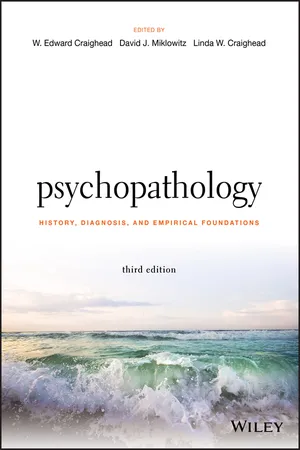
Psychopathology
History, Diagnosis, and Empirical Foundations
- English
- ePUB (mobile friendly)
- Available on iOS & Android
Psychopathology
History, Diagnosis, and Empirical Foundations
About this book
Psychopathology provides unique, state-of-the-art coverage of adult psychopathology as categorical, evidence-based, and continuously evolving. Comprehensive coverage features a detailed examination of DSM disorders, including description, epidemiology, prevalence, consequences, neurobiological and translational research, treatment, and more, with each chapter written by an experts in the field. Mapped to the DSM-5, each chapter includes clinical case examples that illustrate how psychopathology and assessment influence treatment. This new third edition has been updated to align with the latest thinking on alcohol and substance use disorders, sleep-wake disorders, and personality disorders. Students will delve into the DSM system's limitations and strengths, and they will gain deeper insight into the historical context in which today's diagnoses are made.
Advancing research continues to broaden the boundaries of psychopathology beyond traditional lines, revealing its complexity while simultaneously deepening our understanding of these disorders and how to treat them. This book goes beyond DSM descriptions to provide a comprehensive look at the whole disorder, from assessment through treatment and beyond.
- Review DSM-5 classifications matched with illustrative case examples
- Learn the neurobiological and genetic factors related to each disorder
- Understand related behavioral, social, cognitive, and emotional effects
- Delve into translational research, assessment methodologies, and treatment
Contributions from specialists in each disorder provide exceptional insight into all aspects of theory and clinical care. Psychopathology helps students see the whole disorder—and the whole patient.
Frequently asked questions
- Essential is ideal for learners and professionals who enjoy exploring a wide range of subjects. Access the Essential Library with 800,000+ trusted titles and best-sellers across business, personal growth, and the humanities. Includes unlimited reading time and Standard Read Aloud voice.
- Complete: Perfect for advanced learners and researchers needing full, unrestricted access. Unlock 1.4M+ books across hundreds of subjects, including academic and specialized titles. The Complete Plan also includes advanced features like Premium Read Aloud and Research Assistant.
Please note we cannot support devices running on iOS 13 and Android 7 or earlier. Learn more about using the app.
Information
Chapter 1
Diagnosis
Conceptual Issues and Controversies
General Terminological Issues
Functions of Psychiatric Diagnosis
Diagnosis as Communication
Establishing Linkages With Other Diagnoses
Provision of Surplus Information
Table of contents
- Cover
- Title Page
- Copyright
- Dedication
- Table of Contents
- Preface
- Acknowledgments
- List of Contributors
- Chapter 1: Diagnosis
- Chapter 2: Social Anxiety Disorder
- Chapter 3: Panic Disorder
- Chapter 4: Generalized Anxiety Disorder
- Chapter 5: Obsessive‐Compulsive and Related Disorders
- Chapter 6: Posttraumatic Stress Disorder
- Chapter 7: Depressive Disorders
- Chapter 8: Bipolar Disorder
- Chapter 9: Sleep‐Wake Disorders
- Chapter 10: Schizophrenia and the Psychosis Spectrum
- Chapter 11: Alcohol Use Disorder
- Chapter 12: Eating Disorders
- Chapter 13: Sexual Dysfunctions
- Chapter 14: Borderline Personality Disorder
- Chapter 15: Psychopathy as Psychopathology
- Index
- End User License Agreement